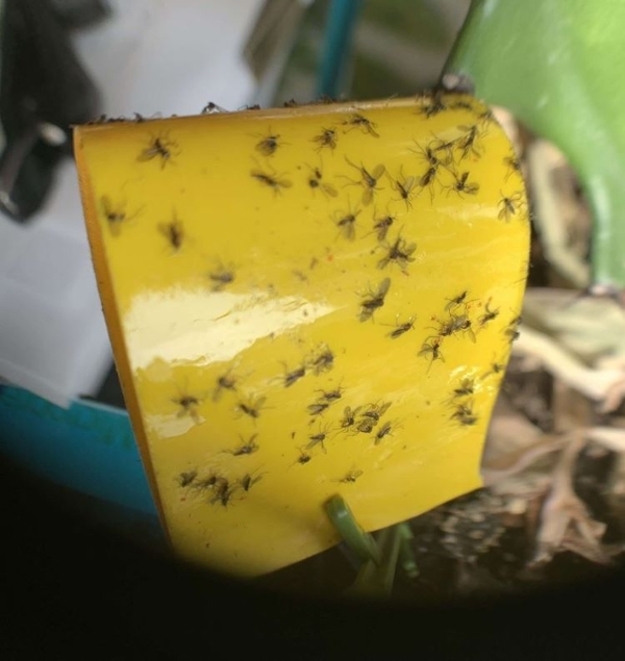Description and Life Cycle

Fungus gnats (Bradysia spp.) are small insects that are commonly found in and around the growing media of household plants. Adults are about 3 mm in length and resemble tiny mosquitoes with long legs and antennae. Their bodies are usually black or dark in colour while their wings are clear with a Y-shaped vein. Adult female fungus gnats lay up to 200 eggs in the crevices of potting soil or vermicompost. The eggs hatch into larvae which mature into pupae in about 2 – 3 weeks and become fully mature flies at 4 weeks. Fungus gnats are attracted to light, including LED grow lights and computer screens. These pests can be a problem in houseplants, when growing seedlings indoors under lights or in vermicomposters.
The adult flies are harmless because they are at the end of their life cycle and do not feed at all. It's the fungus gnat larvae that are the problem. The larvae are about 6 mm long with a shiny black head and a white or translucent legless body. They live in the top 5 – 7 mm of moist potting soil in pots or worm bins. You might even see tiny silvery slime trails left by the larvae on the surface. The larvae feed mostly on fungi, algae and decaying plant matter, but can also cause minor damage to plant roots or leaves resting on the surface of the soil. This can lead to stunted plant growth and even plant death in severe cases.
At this point, you might be asking yourself: how did they even get there? The answer is simple, they were most likely introduced through potting media or compost. While this answer may make it seem like fungus gnats are an unavoidable problem, there are ways to prevent and control them.Prevention
- Remove debris like fallen fruit or leaves from the surface of your plant pots.
- Provide adequate drainage and avoid overwatering plants.
- Collect fruit and vegetable waste for worm bins in sealed containers. If you need to stockpile, store them in your freezer to kill any fruit fly larvae. Freezing also helps to break down plant cell walls which makes the scraps decompose faster. Thaw the frozen food to room temperature before putting it in the worm bin.
- Ensure that food scraps are always well covered by bedding in your worm bin.
Detection
- Use sticky traps or fly tape in your plant pots or worm bins for early detection. Secure sticky traps or fly tape to the inside lid and sides of your worm bin. This can reduce their numbers but will not get rid of them entirely.
- Make a potato lure. Place a 3 cm chunk of peeled potato on the surface of the soil or in your worm bin. The larvae will congregate at the bottom of the potato piece.
Control
- Allow the top of potting soil in plant pots to dry to a depth of 5 – 7 mm, where the larvae live. The eggs and larvae will not survive in a dry habitat. Use your fingers to check for dryness.
- Remove decaying plant matter like leaves or dropped fruit from the surface of the potting soil as that is also possible habitat for larvae.
- Remove the top 5 – 7 cm of bedding in worm bins and dispose. Add new, dry bedding. This should quickly reduce fly numbers.
- Bury some food scraps for the worms and then spread a 3 cm layer of dry peat moss over top of the whole bin. Don’t disturb this layer for about 2 weeks.
Sources
Bethke, J. A., & Dreistadt, S. H. (2013, August). Pests in Gardens and Landscapes - Fungus Gnats. UC IPM Online. https://ipm.ucanr.edu/PMG/PESTNOTES/pn7448.html
Fungus gnats and shoreflies in greenhouse crops. Government of Ontario. (2024, April 11). http://www.ontario.ca/page/fungus-gnats-and-shoreflies-greenhouse-crops

